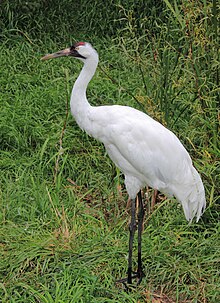Whooping cranes
| Whooping crane | |
|---|---|
 |
|
| Scientific classification | |
| Kingdom: | Animalia |
| Phylum: | Chordata |
| Class: | Aves |
| Order: | Gruiformes |
| Family: | Gruidae |
| Genus: | Grus |
| Species: | G. americana |
| Binomial name | |
|
Grus americana (Linnaeus, 1758) |
|
 |
|
| Distribution map of the whooping crane. blue: breeding, orange: wintering, green: year-round, grey: experimental year-round | |
The whooping crane (Grus americana), the tallest North American bird, is an endangered crane species named for its whooping sound. In 2003, there were about 153 pairs of whooping cranes. Along with the sandhill crane, it is one of only two crane species found in North America. The whooping crane's lifespan is estimated to be 22 to 24 years in the wild. After being pushed to the brink of extinction by unregulated hunting and loss of habitat to just 21 wild and two captive whooping cranes by 1941, conservation efforts have led to a limited recovery. As of February 2015, the total population was 603 including 161 captive birds.
An adult whooping crane is white with a red crown and a long, dark, pointed bill. Immature whooping cranes are cinnamon brown. While in flight, their long necks are kept straight and their long dark legs trail behind. Adult whooping cranes' black wing tips are visible during flight.
The species can stand up to 1.5 meters (4.9 feet) and have a wingspan of 2.3 meters (7.5 feet). Males weigh on average 7.3 kg (16 lb), while females weigh 6.2 kg (14 lb) on average (Erickson, 1976). The body length averages about 132 cm (52 in). The standard linear measurements of the whooping cranes are a wing chord length of 53–63 cm (21–25 in), an exposed culmen length of 11.7–16 cm (4.6–6.3 in) and a tarsus of 26–31 cm (10–12 in). The only other very large, long-legged white birds in North America are: the great egret, which is over a foot shorter and one-seventh the weight of this crane; the great white heron, which is a morph of the great blue heron in Florida; and the wood stork. All three other birds are at least 30% smaller than the whooping crane. Herons and storks are also quite different in structure from the crane.
Their calls are loud and can carry several kilometers. They express "guard calls", apparently to warn their partner about any potential danger. The crane pair will jointly call rhythmically ("unison call") after waking in the early morning, after courtship and when defending their territory. The first unison call ever recorded in the wild was taken in the whooping cranes' wintering area of the Aransas National Wildlife Refuge during December 1999 and is documented here
...
Wikipedia

